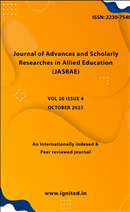A Pragmatic and Liberal Approach to Nepal India Relations: A Comprehensive Analysis
Keywords:
Border, political, social, relationshipAbstract
We begin with historical narratives that represent Nepal-India ties as being built on historical, cultural, economic, and geopolitical dimensions and mutual respect of sovereignty. The Nepal-India relationship is complex and multifaceted, with historical, cultural, economic, and geopolitical dimensions. A liberal and realistic view on this relationship in the contemporary geopolitical context would involve acknowledging both the positive aspects of cooperation and addressing the challenges that have emerged over time. A liberal perspective would emphasize the deep cultural and historical ties between Nepal and India. They both share social, economic, and political advancement. Problems, hazards, and uncertainties have been brought about as a result of globalization in relation to the flow of people, products, and capital. Because of this, border governance has developed among states, which necessitates the cooperation of neighboring states in the development of border management systems. The research was a qualitative study that followed the "practice turn" in International Relations (IR) and took into consideration human actions that affect social realities. The research focused on the open border between Nepal and India during this time period. According to the research, the open border that exists between Nepal and India provides a number of specific benefits along with risks and challenges. Within this essay, a concise explanation of border government is provided. It describes theories and techniques, as well as recommends border governance for open borders between Nepal and India. The issues of border governance for Nepal-India boundaries is emphasized in the study, which acknowledges the existence of border disputes and significant footraces.
References
There are no sources in the current document. Border Disputes Between India and Nepal: Will India Act as a Responsible Rising Power?
By Dr DB Subedi and Bikram Timilsina National Human Rights Commission of Nepal (NHRC) 2020
Hannan, A. (2018). Geography of informal trade, commodity flows and livelihoods in IndoNepal border. Business Management & Compliance,1(2), 7-29. https://osderpublications. com/uploads/1568726955.pdf
Baral, L.R., & Pyakurel, U.P. (2016). Nepal-India open borders: Problems and prospects. Vij Books India Pvt. Ltd.
Dhungana, N. (2022, November 10). Home Ministry: India-Nepal cross-border smuggling rife in cahoots with bureaucrats, politicians. Online Khabar. https://english.onlinekhabar. com/cross-border-smuggling-cahoots.html
Giri, A. (2022, March 6). Government decides to allow Bhutanese refugees to do business. The Kathmandu Post: https://kathmandupost.com/national/2022/03/06/government-decidesto-allow-bhutanese-refugees-to-do-business
Upreti, Y. (2021). Issues in border security of Nepal. Journal of APF Command and Staff College, 4(1), pp.152-160. https://doi.org/10.3126/japfcsc.v4i1.34145
Sanjeewani, DGN (2019). Rohingya refugees in Nepal: Going beyond the discourse on integration. General Sir John Kotelawala Defence University, Sri Lanka. http://ir.kdu.ac.lk/handle/345/2069
United Nations High Commission for Refugees. (2020). Nepal. https://reporting.unhcr.org/ sites/default/files/UNHCR%20Nepal%20fact%20sheet%20November%202020_0.pdf
www.efsas.org/publication/study -paper/misuse -of- nepal’s territory by -palistan’s -intelligence agencies to forment terrorism
Prof. (Dr.) C. B. Bhange, Ajay Kumar & Arbind Kumar- South Asia Security & Peace Challenges 2021 Research Gate
Prof. (Dr.) Baral L.R. "Realism Not Idealism Important In Nepal India Border" Spotlight Vol: 08 No. -4 July. 25- 2014
DB Subedi School of Humanities, Arts and Social Sciences (HASS) at the University of New England in Australia.
Bikram Timilsina is a PhD scholar in Griffith Asia Institute and School of Government and International Relations at Griffith University Australia.
Adhikari, Dhruba. R. 2018. A Small State between Two Major Powers: Nepal’s Foreign Policy Since 1816. Journal of International Affairs, 2:1, 43-74.
Adichie, Chimamanda. N. 2009. The Danger of a Singly Story. Accessed on March 30, 2020 https://www.ted.com/talks/chimamanda_adichie_the_danger_of_a_single_story/transcri pt?language=en.
Barnett, Michael, and Raymond Duvall. 2005. Power in International Politics. International Organization 59:1, 39–75.
Bharadwaj, Narad. n.d. Why Anti-Indian Sentiment Grows in Nepal? Accessed on March 30, 2020 http://therisingnepal.org.np/news/8561
Bloomfield, Alan. 2014. Review of India in South Asia: Domestic Identity Politics and Foreign Policy from Nehru to the BJP, 2013 by Sinderpal Singh, Oxon: Routledge.
Carr, Edward. H. 1971. The Twenty Years’ Crisis, 1919-1939: An Introduction to the Study of International Relations (2nd Ed.). London: Macmillan.








